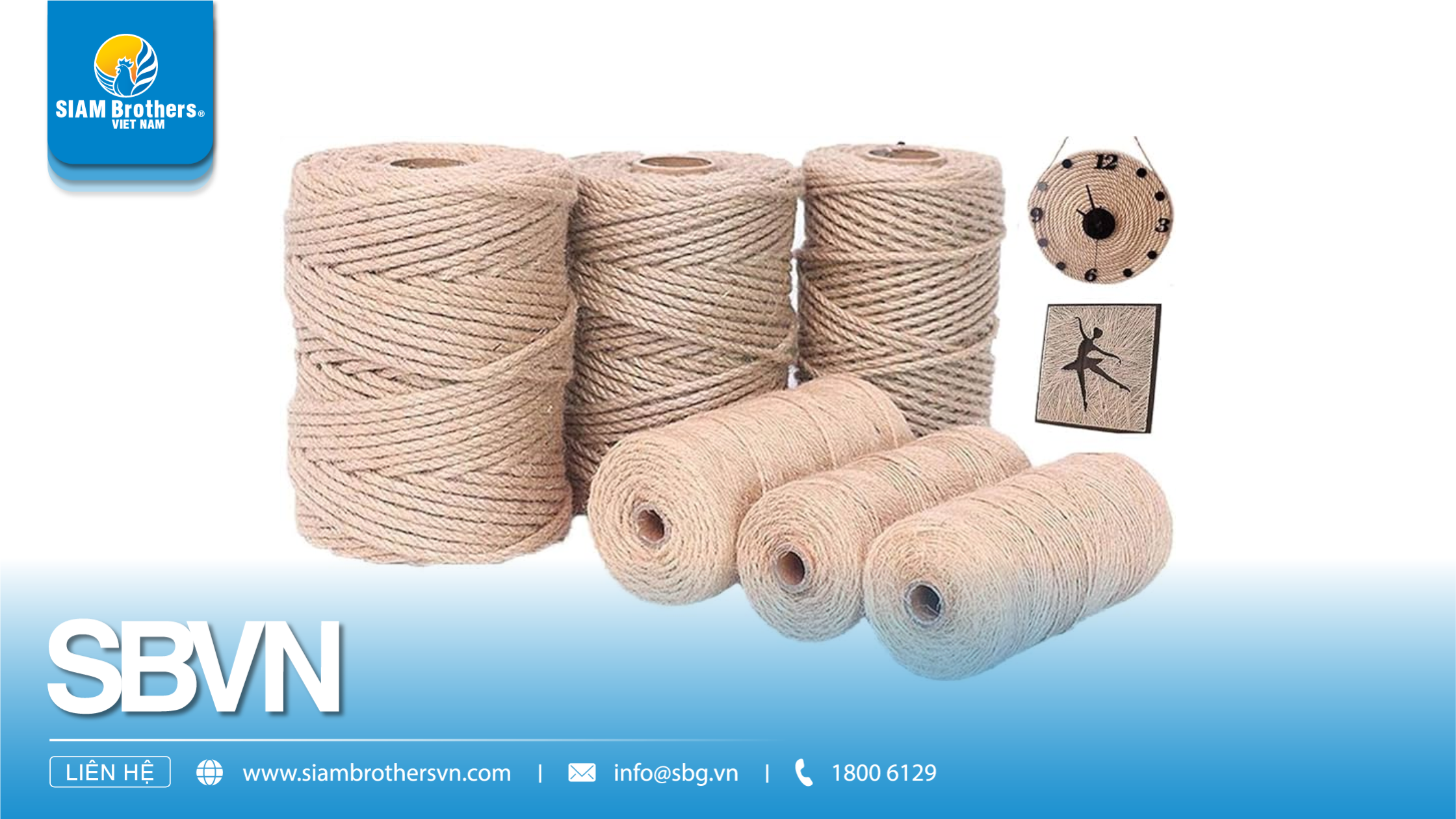What Are Ropes Made Of? Ropes, a familiar yet often overlooked tool, are crafted from a diverse range of materials. From eco-friendly natural fibers like jute, coconut, and cotton to durable synthetic options such as PE, PP, and Nylon, each material offers unique characteristics and applications. Join SIAM Brothers Vietnam as we explore the details of various ropes and help you choose the one that best fits your needs.
Ropes, an essential tool in both daily life and industrial applications, are made from a variety of materials. Have you ever wondered what ropes are made of and why they are so durable and versatile?
Ropes made from natural fibers have been a popular choice for centuries due to their eco-friendliness and biodegradability. Commonly used natural fibers include:
Jute:
Coconut Fiber:
Cotton:
While natural fiber ropes are environmentally friendly, they are less resistant to harsh conditions and degrade faster than synthetic alternatives.
 Ropes Made of Natural Fibers - Source: SIAM Brothers Vietnam
Ropes Made of Natural Fibers - Source: SIAM Brothers Vietnam
>> Read more: Popular Types of Rope Coils – How to Choose the Best Fit?
If durability and resistance to environmental factors are what you need, synthetic fiber ropes are an excellent choice. Popular synthetic materials include:
PP (Polypropylene):
Nylon:
Although synthetic ropes are not biodegradable, their durability makes them ideal for long-term applications.
 Ropes Made of Synthetic Fibers - Source: SIAM Brothers Vietnam
Ropes Made of Synthetic Fibers - Source: SIAM Brothers Vietnam
Composite fiber ropes combine the strengths of both natural and synthetic materials. These ropes are highly durable, weather-resistant, and versatile, making them suitable for modern industrial applications such as ship mooring, cargo transport, and advanced technical uses.
Jute:
Coconut Fiber:
Cotton:
 Ropes Made of Natural Fibers - Source: Internet
Ropes Made of Natural Fibers - Source: Internet
>> Read more: Why Large-Sized Ropes Are a Valuable Investment for Your Work?
Polyethylene (PE):
Polypropylene (PP):
Nylon:
Composite Fibers
| Material Type | Advantages | Disadvantages | Typical Applications |
| Natural Fibers | Eco-friendly | Prone to rotting, less durable | Packaging, decoration |
| Synthetic Fibers | Durable, excellent water resistance | Non-biodegradable, environmental impact | Fisheries, industrial use |
| Composite Fibers | Versatile, superior durability | Higher cost |
Ship mooring, cargo transport |
 Ropes Made of Synthetic Fibers - Source: SIAM Brothers Vietnam
Ropes Made of Synthetic Fibers - Source: SIAM Brothers Vietnam
>> Read more: Cock Rope: Things You Should Know About Top 1 Rope in Vietnam
► Common Materials:
► Key Features:
► Recommendation: Opt for synthetic fiber ropes to ensure high performance and long lifespan.
 Ropes for Fisheries Applications - Source: Internet
Ropes for Fisheries Applications - Source: Internet
► Common Materials:
► Key Features:
► Recommendation: PP ropes are a cost-effective and efficient choice for general agricultural needs.
 Ropes for Agriculture and Farming Applications - Source: Internet
Ropes for Agriculture and Farming Applications - Source: Internet
► Common Materials:
► Key Features:
► Recommendation: Composite fiber ropes provide the best solution for technical and heavy-duty requirements.
 Ropes for Heavy-Duty Industrial Applications - Source: Internet
Ropes for Heavy-Duty Industrial Applications - Source: Internet
► Common Materials:
► Key Features:
► Recommendation: Choose natural fiber ropes for decorative purposes or PP ropes for cost efficiency in everyday use.
| Rope Type | Fisheries | Agriculture | Heavy Industry | Daily Life |
| PE Fiber | ✔ Water-resistant | ❌ Not suitable | ✔ Strong load capacity | ❌ Not necessary |
| PP Fiber | ✔ Affordable | ✔ Cost-effective | ❌ Cannot handle heavy loads | ✔ Commonly used |
| Nylon Fiber | ✔ High durability | ❌ Expensive | ✔ Ideal for heavy industry | ❌ Rarely used |
| Natural Fibers | ❌ Not durable | ✔ Eco-friendly | ❌ Not strong enough | ✔ Decorative, handicrafts |
Each type of rope is designed to meet specific usage needs. When choosing, carefully consider your requirements and the material characteristics to achieve optimal performance. If you're still wondering what are ropes made of or need further advice, contact SIAM Brothers Vietnam for expert support!
 Ropes for Everyday Applications - Source: Internet
Ropes for Everyday Applications - Source: Internet
>> Read more: Natural Rope vs. Synthetic Rope: Which one is better?
The best type depends on its intended purpose:
PE Rope:
PP Rope:
Pros:
Cons:
Synthetic ropes like PE and Nylon are the best options:
SIAM Brothers Vietnam provides high-quality ropes with outstanding benefits:
 Ropes are not only diverse in materials but also specifically designed to suit various purposes – Source: SIAM Brothers Vietnam.
Ropes are not only diverse in materials but also specifically designed to suit various purposes – Source: SIAM Brothers Vietnam.
>> Read more: Where to Buy Rope? Top 3 Trusted & Affordable Suppliers for Fisheries And Multi-Purpose Use
Ropes—though a small tool—play a significant role in many industries. They are crafted from an impressive variety of materials to suit different applications. Through this article, we hope you’ve gained a clear understanding of what ropes are made of and the differences between natural, synthetic, and composite fibers. Choosing the right rope ensures optimal performance and long-term durability. If you're searching for high-quality ropes for any purpose, contact SIAM Brothers Vietnam today for expert consultation and the perfect solution for your needs!
Source: SIAM Brothers Vietnam
Contact Us:
Address: 5th Floor, VRG Building, 177 Hai Ba Trung Street, District 3, Ho Chi Minh City, Vietnam
Phone: (+84) 28 39 912 889
Hotline: 1800 6129 (toll-free)
Facebook: fb.com/siambrothersvn
Email: info@sbg.vn
YouTube: youtube.com/@siambrothersvietnam1728
X (Twitter): x.com/sbvnjsc
Zalo OA: zalo.me/1402339229697925373
SBVN ID App:
Google Play: https://bit.ly/SBVNID-Android
App Store: https://bit.ly/SBVNID-iOS
